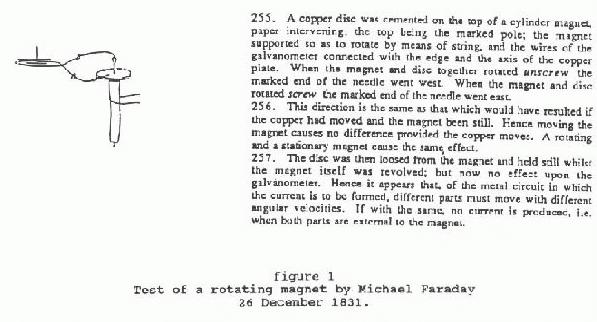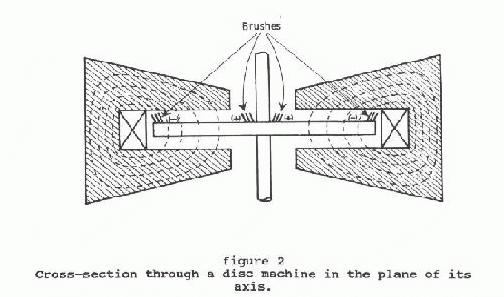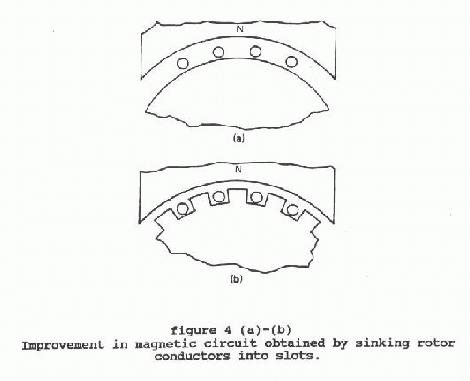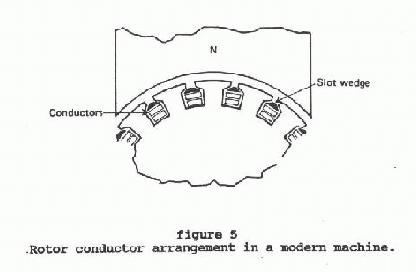
16 July 1993
by Bruce DePalma
"It is characteristic of fundamental discoveries, of great achievements of the intellect, that they retain an undiminished power upon the imagination of the thinker. The memorable experiment of Faraday with a disc rotating between two poles of a magnet, which has borne such magnificent fruit, has long passed into every-day experience; yet there are certain features about this embryo of the present dynamos and motors which even today appear to us striking, and are worthy of the most careful study."
- Nicola Tesla, 1891, New York City, New York
____________________________________________________
Law of Equipartition of Energy: In a given thermodynamic system, the total energy will subdivide itself equally amongst the characteristic modes of the system.
____________________________________________________
After Michael Faraday performed
the initial experiments resulting in the discovery of the one-piece homopolar
generator of December 26, 1831, figure (1), he devoted considerable effort to
reconcile the appearance of generated electrical potential in the apparatus with
his conceptualization of the cutting of flux linkages by a moving
conductor. 
Although Faraday never adduced an
experiment to prove the cutting of flux linkages in the axially rotating magnet
experiment, he was troubled to his last days about his interpretation of his
experiment. It took until 1978 when DePalma, reference (1), did the critical
experiment to determine if the form of electrical induction was the same as the
flux cutting originally proposed by Faraday. The problem has been re-stated by
other workers who would attempt to determine whether flux lines rotate with, or
are spatially independent of the axially rotating magnet. To date, no experiment
has been found either to confirm or disprove the axially rotating flux line
hypothesis, reference (2).

The laudable efforts of Clerk-Maxwell to express in mathematical form the results of the electrical experimentation of Faraday reflect the uncertainty which he had over the interpretation of the 1831 experiment. The result was that Maxwell did not consider the problem at all, or felt he had nothing more to offer.
For those scientists who consider mathematical expressions of physical laws as the only possible descriptions of physical reality, having no mathematical description is tantamount to no physical reality.
Electrical science, which is considered to be completely known, has been ultimately reduced to a completely self-consistent set of equations which are suitably stored in computer memories and are used to design motors, generators, transformers and other sorts of familiar electrical hardware.
The first place electrical science went wrong is when electrical phenomena which were not subject to unambiguous mathematical interpretation were simply omitted from electrical curricula.
The second place electrical science went wrong is concisely illustrated in a sequence of evolution of electrical machinery abstracted from "Exciting Electrical Machines", by E. R. Laithwaite, D.Sc., Ph.D., C.Eng., F.I.E.E., F.I.E.E.E. Professor of Heavy Electrical Engineering, Imperial Technical College, London, England. Reference (3).
"The various steps shown in figure [3 (a)-(d)] do not represent an historical sequence. They represent an attempt to break down the topological difference between Faraday's disc and an early type of commercial machine into simple basic steps. Figure [ 2 ] shows a cross section through the disc machine. In theory the two brushes marked (+) would be part of a continuous annular brush at the centre; likewise the (-) brush extends all around the periphery. This arrangement is represented diagrammatically in figure 3(a). The first step consists of elongating the disc axially so that it forms a cylinder. The magnetic circuit is then re-arranged so that the flux enters the rotor through one end of the cylinder and emerges through the periphery, as shown in figure 3(b). If the rotor were of solid copper, the magnetic circuit through it would be poor. The rotor is therefore modified to consist of a hollow cylinder filled with iron, as shown in cross-section in figure 3(c). For ease of mounting the rotor, i.e. with a bearing at each end, the iron core is made integral with the conducting cylinder and the two rotate as one unit.

"The dimensions of the rotor are next changed to take advantage of the fact that the useful e.m.f. is generated along AB (figure 3(c)) rather than BC, i.e. between the brushes. The diameter is reduced and the length increased. The axial direction, however, now represents a bottleneck in the magnetic circuit, even though the machine can be flux fed from both ends, as shown in figure 3(d). The solution to this situation is to send the flux right through the rotor, as shown in figure 3(e)."

In a manner so casual so as to escape attention Laithwaite alters the magnetic field direction from flux lines parallel to the axis of rotation to flux lines perpendicular to the rotational axis. This fundamental change and the unstated ambiguity: do flux lines rotated in the manner shown, figure 3(e) ipso facto demand a two-piece machine, figure 3(f)? If the two piece, i.e. rotor-stator construction is implicit for electrical machines where the flux lines through the rotor are perpendicular to the axis of rotation, then what has this to do with the archetypal one-piece Faraday homopolar machine which does not require a stator. Is the evolution suggested by Laithwaite an evolution or the description of two fundamentally different families of electrical machines?
We continue with Laithwaite: "Notice that this means that two sets of brushes are now needed, since the polarity of the e.m.f. around one arc of 180 degrees is opposite that around the other. The plane of the magnetic circuit can now, with advantage, be turned through a right angle so that a cross-section of the machine is as shown in figure 3(f). This is the point where the rotor conductor is split into individual wires which can be connected in series. To do this it appears to be necessary to use a hollow iron core and to connect each wire at end X (figure 3(g)) to the next, at end Y, by means of a wire passing up the centre of the core."
In his dissertation Dr. Laithwaite has made a number of assumptions, which, in the light of contemporary knowledge, can be questioned. I am not singling out Dr. Laithwaite as being defective in his reasoning, but his position of authority is representative of the presently accepted level of knowledge of electrical science.
The first assumption:
That there is a relationship between the Faraday disc and the two piece induction machine of commerce.
The second assumption:
That there is no difference in behavior of electrical machines if the source of flux moves with the rotor or not.
The third assumption:
That there is no difference in the behavior of electrical machines if the flux lines are either parallel or perpendicular to the axis of rotation of the machine.
The fourth assumption:
Flux cutting is the only mechanism for the generation of electricity from magnetism.
It is left to the reader to intellectually explore the implications of the first three assumptions on the evolution suggested in figures 3(a)-(g).
That the fourth assumption is suspect is ably illustrated by a second extract from Laithwaite.
"Figure [4(a)] shows that surface conductors demand a gap in the magnetic circuit which must increase with increase in thickness of conductors, which in turn is demanded by an increased current loading, whereas a conductor system in slots as in figure 4(b) can combine thick conductors and small airgap in one arrangement. Quite apart from magnetic considerations, conductors on the surface are liable to become displaced around the periphery, aided by the speed of rotation which tends to stretch and loosen the conductors. If the conductors are constrained in a slot, and held in by a non-metallic slot wedge as shown in figure [5], the speed of the machine, and therefore its output, can be increased without suffering these effects of rotation.


"The big question, however, is whether the machine will still function at all. After all, the magnetic flux will now take the line of least reluctance and cross the gap only opposite the rotor 'teeth'. The flux now cutting the conductors is now perhaps only 10% of that which cuts the conductors of a surface-wound motor. Will the output voltage therefore be only 10% also, as apparently dictated by the flux cutting rule? For a long time no one would try the slotted rotor, because they did not believe in the 'magic' of electromagnetism. They believed they knew all the answers. Worst of all, they did not realise that only circuits mattered and that so long as a machine broke and re-made linkages between magnetic and electric circuits the answer would be the same whether the conductors were buried or not."
It is not all of us who conceal our ignorance by appeal to the belief in the "magic" of electromagnetism. The fact that the modern two piece wound rotor machine works at all speaks to the operation of electrical laws outside the computer controlled algorithms now representative of electrical science.
The fifth assumption:
The fifth assumption is that all the laws of electrical science must be consistent with the energy conservation laws. Is this why the "magic" of electromagnetism is necessary?
To quote Laithwaite once more: "It is to be hoped that we are all not suffering from similar inhibitions when we design our modern machines."
Bruce DePalma
References:
1. Magnetism as a Distortion of a Pre-Existent Primordial Energy Field and the Possibility of Extraction of Electrical Energy Directly from Space, Bruce DePalma; proceedings of the 26th annual Intersociety Energy Conversion Engineering Conference (IECEC), Boston, Massachusetts, August 4-9, 1991.
2. "Spinning Magnetic Fields", Djuric; Journal of Applied Physics, vol. 46, no. 2, February 1975, pp. 679-688.
3. Exciting Electrical Machines, E. R. Laithwaite, pp. 13-17; Pergamon Press Ltd., Oxford, England, 1974.